GWR 4073 Class
The 4073 Class or Castle class were 4-6-0 steam locomotives of the Great Western Railway, built between 1923 and 1950.[1] They were designed by the railway's Chief Mechanical Engineer, Charles Collett, for working the company's express passenger trains.
| GWR 4073 Castle class | |||||||||||||||||||||||||||||||||||||||||||||||||||||||||||
|---|---|---|---|---|---|---|---|---|---|---|---|---|---|---|---|---|---|---|---|---|---|---|---|---|---|---|---|---|---|---|---|---|---|---|---|---|---|---|---|---|---|---|---|---|---|---|---|---|---|---|---|---|---|---|---|---|---|---|---|
 5002 Ludlow Castle with a Parcels train in 1962 | |||||||||||||||||||||||||||||||||||||||||||||||||||||||||||
| |||||||||||||||||||||||||||||||||||||||||||||||||||||||||||
| |||||||||||||||||||||||||||||||||||||||||||||||||||||||||||
| |||||||||||||||||||||||||||||||||||||||||||||||||||||||||||
| |||||||||||||||||||||||||||||||||||||||||||||||||||||||||||
Background
The origins of this highly successful design date back to the Star Class of 1907 which introduced the basic 4-cylinder 4-6-0 layout with long-travel valves and Belpaire firebox that was to become characteristic of GWR express passenger locomotives. The Star class was designed to take the top express trains on the GWR, with 61 in service by 1914, but after World War 1 there was a need for an improved design. To meet this need, Chief Mechanical Engineer GJ Churchward had in mind an enlarged Star class design with a standard No.7 boiler, as fitted to his GWR 4700 Class express freight 2-8-0.[2] However, this combination would have taken the axle load over the 20-ton limit then set by the civil engineers, and in the end, nothing came of the idea.
Design
C. B. Collett succeeded Churchward as Chief Mechanical Engineer of the GWR in 1922 and immediately set about meeting the need for a new locomotive design that would both supplement the Stars and replace them on the heaviest expresses. Collett's solution was to take the basic layout of the Star with an extended frame, and add a newly designed No.8 boiler which was both larger and lighter.[3] The increased amount of steam that this produced allowing an increase in the cylinder diameter from 15 in × 26 in (381 mm × 660 mm) to 16 in × 26 in (406 mm × 660 mm). The extended frame allowed for a side window cab and an increased grate area. The result was an increase in tractive effort to 31,625 lb, and a locomotive that looked attractive and well proportioned while remaining within the 20-ton axle limit.
Production
Unlike the Star class, there was no prototype. Collett was sufficiently confident of the design to place an order with Swindon railway works (Lot 224) for ten locomotives in 1923, although there was a four-month delay between the appearance of the first example in August 1923 and the second in December, to allow for the correction of any teething problems.[4] Thereafter the remaining eight locomotives came out at regular intervals until April 1924. They were 4073–4082, the number series continuing unbroken from the Star class. The last 12 Star class locomotives, which were built in 1922–23, had been given names of abbeys in the western area served by the GWR. The new locomotives were named after castles, also in the west, beginning with 'Caerphilly Castle'.
Over the twenty-seven years from August 1923 to August 1950, 155 Castles were built new at Swindon Works and a further sixteen were converted from other classes. In February 1952, two engines, 4082 Windsor Castle and 7013 Bristol Castle, swapped names and numbers: 7013 was disguised as 4082 to run George VI's funeral train and the numbers were never swapped back. 4082 was withdrawn from service in 1964 as 7013 and 7013 was withdrawn from service as 4082 in 1965.
New builds
The new-builds were as follows.[5]
Great Western Railway
- Lot 224: Nos. 4073 - 4082, delivered August 1923 – April 1924.
- Lot 232: Nos. 4083 - 4092, delivered May to August 1925.
- Lot 234: Nos. 4093-4099 and 5000 to 5012, delivered May 1926 – July 1927.
- Lot 280: Nos. 5013-22, delivered June–August 1932.
- Lot 295: Nos. 5023-32, delivered June–August 1932.
- Lot 296: Nos. 5033-42, delivered May–July 1933.
- Lot 303: Nos. 5043-67, delivered March 1936 – July 1937. (Nos. 5043–5063 were originally named after Castles, but were renamed in 1937 after Earls)
- Lot 310: Nos. 5068-82 delivered June 1938 – June 1939. (Nos. 5069 and 5070 were named after Isambard Kingdom Brunel and Sir Daniel Gooch; In 1941 5071–5082 were renamed after war planes used by the Royal Air Force)
- Lot 324: Nos. 5093-97, delivered June–July 1939.
- Lot 357: Nos. 5098-99, 7000-7 delivered May–July 1946.
British Railways (Western Region)
- Lot 367: Nos. 7008-27, delivered May 1948 – August 1949.
- Lot 375: Nos. 7028-37, delivered May 1950 – August 1950.
These locomotives were built with minimal changes to the dimensions. However, from 5013 Abergavenny Castle there was an alteration to the shape of the front-end casing over the inside cylinders, and from 5043 Earl of Mount Edgcumbe a shorter chimney was fitted.[6] Those built before 1926 were fitted with a 3,500 imp gal (16,000 l; 4,200 US gal) tender but thereafter 4,000 imp gal (18,000 l; 4,800 US gal) became standard for the class.
Rebuilds
Between January and September 1924, the only Great Western 4-6-2, No.111 The Great Bear, was rebuilt into a member of the Castle Class, although only the "front portion of the original frames and the number plates were used again but probably little else". The new locomotive was renamed Viscount Churchill and survived until withdrawal in July 1953.[2]
In April 1925, Star class No. 4009 Shooting Star was likewise rebuilt as a Castle by extending the frames and fitting a new Castle Class boiler and cab. It was renumbered and renamed 100 A1 Lloyds and was withdrawn in 1950.[7]
In October 1925 a second Star class, No. 4016 The Somerset Light Infantry (Prince Albert's), was similarly converted to a Castle although in this case, it retained its name and number.[2] Two further conversions of Stars were undertaken in 1926; Nos. 4032 Queen Alexandra and 4037 The South Wales Borderers retaining their names and numbers and surviving until 1951 and 1962 respectively.
In November 1929 the prototype for the Star Class, No. 4000 "North Star" was rebuilt into a Castle, being subsequently withdrawn in 1957.
Between 1937 and 1940 a further ten members of the 'Abbey series' of the Star class (Nos. 4063-72) were rebuilt as Castles, They were allocated new numbers 5083 to 5092 but retained their original names and were withdrawn between 1958 and 1964.
Publicity and trials

When introduced they were heralded as Britain’s most powerful express passenger locomotive, being some 10% more powerful than the Stars. The first, No. 4073 Caerphilly Castle, made its debut at Paddington station on 23 August 1923. The choice of 4082 as Windsor Castle proved fortuitous as this locomotive was used to haul the royal train when King George V and Queen Mary visited Swindon Works in 1924, and much publicity was gained when the king was invited to drive the engine back from the works to the station before the return journey, with the Queen and several high-ranking GWR officers also on the footplate.[6]

During 1924, 4073 Caerphilly Castle was exhibited at the British Empire Exhibition at Wembley, alongside Sir Nigel Gresley’s Flying Scotsman. The Great Western declared their engine to be more powerful than its bigger LNER rival, and in terms of tractive effort alone they were entitled to do so. As a result of this, GWR General Manager Sir Felix Pole proposed to LNER Southern Area General Manager Alexander Wilson that a trial of the two types should take place via an exchange arrangement.[8] The resulting trials commenced in April 1925 with 4079 Pendennis Castle representing the GWR on the Great Northern main line and 4474 Victor Wild representing the LNER on Great Western tracks. On the first morning Pendennis Castle was to work a 480-ton train from King's Cross to Doncaster, and LNER officials fully expected the smaller, lighter engine to encounter problems climbing Holloway Bank. However, railway writer Cecil J. Allen records that the GWR locomotive made a faster start from King's Cross to Finsbury Park than any LNER Pacific he had recorded up to that time,[8] and over the trial Pendennis Castle kept well within the scheduled time and used less coal, considerably denting LNER pride. For the LNER, Victor Wild was compared on the Cornish Riviera Express to 4074 Caldicot Castle and although it kept to time the longer wheelbase of the Pacific proved unsuited to the many curves on the route. Again the GWR took the honours with Caldicot Castle burning less fuel and always ahead of time, this being illustrated on the last 2 days of the trial by gaining 15 minutes on the schedule in both directions.[8]
In 1926, number 5000 Launceston Castle was loaned to the London, Midland and Scottish Railway where it ran trials between London and Carlisle. The locomotive fulfilled the LMS requirements so well that the latter first requested the GWR to build a batch of Castles for use on the West Coast Main Line, and, failing that, a full set of construction drawings. Both proposals were rejected by the GWR Board of Directors. The LMS eventually succeeded in gaining access to the design by recruiting William Stanier, the GWR's Works Manager at their main Swindon railway works to become the new Chief Mechanical Engineer for the LMS.[9]
Performance
The Castles handled all but the heaviest loads, these being entrusted to the 30-strong King Class, themselves a development of the Castles with an even larger boiler and smaller wheels (6'6" diameter) for both increased tractive effort and to allow for loading gauge clearance.
The Castle class was noted for superb performance overall, and notably on the Cheltenham Flyer during the 1930s: for example, on 6 June 1932 the train, pulled by 5006 Tregenna Castle, covered the 77.25 miles from Swindon to Paddington at an average speed of 81.68 mph start-to-stop (124.3 km at an average speed of 131.4 km/h). This world record for steam traction was widely regarded as an astonishing feat.[6]
Subsequent modification
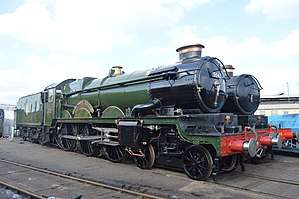
In 1946 Frederick Hawksworth, Collett’s successor, introduced a higher degree of superheat to the Castle boiler with resulting increased economy in water consumption. From 1956 the fitting of double chimneys to selected engines, combined with larger superheaters, further enhanced their capacity for sustained high-speed performance. The fastest recorded speed of a Castle Class engine was 102 mph achieved by 7018 Drysllwyn Castle at Little Somerford in April 1958 while hauling The Bristolian in the Up direction from Bristol to London. The non-stop run over 117.6 miles took 93 minutes 50 seconds, an average speed of more than 75 mph.[10][11]
Accidents and incidents
- On 30 November 1948, a passenger train hauled by 5022 Wigmore Castle overran signals and was in collision with locomotive 4150, which was running round its train at Lapworth.[12] Eight passengers were injured.[13]
- On 12 November 1958, a freight train overran signals and was derailed at Highworth Junction, Swindon, Wiltshire. Locomotive No. 5009 Shrewsbury Castle was hauling a newspaper train which collided with the wreckage.[14]
Withdrawal
Withdrawal of steam power started in the 1950s, with the first 100 A1 Lloyds withdrawn from Old Oak Common in March 1950. The first "new build" Castle, number 4091 Dudley Castle, was withdrawn from Old Oak Common nearly 9 years later in January 1959.
The lowest mileage of a Castle was the 580,346 miles run by 7035 Ogmore Castle between August 1950 and June 1964; the highest mileage of any Castle class was by 4080 Powderham Castle which totalled 1,974,461 miles in 40 years and 5 months.
The last three Castles to be withdrawn were all allocated to Gloucester shed,[15] with 5042 Winchester Castle and 7022 Hereford Castle withdrawn in June 1965. The last to be withdrawn was Clun Castle in December 1965, which worked the last steam train out of Paddington on 27 November 1965.[16]
| Year | Quantity in service at start of year | Number withdrawn | Quantity withdrawn | Locomotive numbers | Notes |
|---|---|---|---|---|---|
| 1950 | 171 | 1 | 1 | 4009 | |
| 1951 | 170 | 2 | 3 | 4016/32 | |
| 1953 | 168 | 1 | 4 | 111 | |
| 1957 | 167 | 1 | 5 | 4000 | |
| 1958 | 166 | 1 | 6 | 5086 | |
| 1959 | 165 | 3 | 9 | 4091, 5010/83 | |
| 1960 | 162 | 7 | 16 | 4073/84/97, 5005/09/28/79 | 4073 preserved |
| 1961 | 155 | 4 | 20 | 4037/75/83/92 | |
| 1962 | 151 | 54 | 74 | 4077–78/85–86/94–95/99,
5003–04/06–08/11–13/16–17/19–21/24/27/30/32–36/44–48/52–53/59, 5061/62/64/66–69/72/75/77–78/82/84/88/90/94–95, 7016 |
|
| 1963 | 97 | 49 | 123 | 4074/76/81/87/90/96/98,
5001/15/22–23/25/29/31/38/40–41/43/49–51/58/60/65/71/80–81/87/92–93/97/99, 7000–01/06–07/09/15/17–18/20–21/27–28/30–31/33/36–37 |
5029, 5043, 5051, 5080 & 7027 preserved |
| 1964 | 48 | 36 | 159 | 4079–80/82/88–89/93,
5000/02/18/26/37/39/54–57/70/73–74/76/85/89/91/96/98, 7002–05/08/10/12/19/25–26/32 |
4079 preserved |
| 1965 | 12 | 12 | 171 | 5014/42/63, 7011/13–14/22–24/29/34–35. | 7029 preserved |
List of locomotives
Preservation
On 4 March 1967, Nos. 7029 Clun Castle and 4079 Pendennis Castle hauled specials from Banbury and Oxford respectively to Chester, to mark the end of through trains between Paddington and Birkenhead. These two, and six other Castles, survive in preservation.
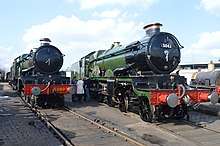
Of the eight Castles to be preserved, six have operated in preservation. Three were purchased from BR for preservation (4073, 4079 and 7029) with the remaining five being rescued from Barry Scrapyard. All of the engines that have operated have also been out on the main line: nos. 4079 Pendennis Castle, 5029 Nunney Castle, 5043 Earl of Mount Edgcumbe, 5051 Earl Bathurst, 5080 Defiant and 7029 Clun Castle.
No. 4073 Caerphilly Castle was given directly to the National Collection upon withdrawal and has not run since being preserved; it can currently be found at Steam, Museum of the Great Western Railway in Swindon. No. 7027 Thornbury Castle was in ex-Barry Scrapyard condition and is undergoing restoration. In July 2016 it was sold from Pete Waterman to the Somerset transport firm JJP Holdings SW Limited and was transported to Weston-super-Mare on a low loader, where she was placed on a temporary track in the Crosville Motor Services bus depot. In summer 2018 she was moved briefly to Tyseley Locomotive Works in Birmingham to make an appearance at their open weekend before moving to its planned home at the West Somerset Railway where the engine was to be restored. It is now located at Loughborough on the Great Central Railway where it is to now be restored.[17] 7027 will however not be restored to mainline standards as its current owner intends to run it for its first ticket at the GCR before considering future mainline certification.
Two of the eight preserved castle's nos. 5043 Earl of Mount Edgcumbe and 7029 Clun Castle are fitted with double chimneys while the remaining six are still fitted with the original singles.
4079 hauled a small number of railtours on the main line in its early preservation years before departing for Australia in 1973; it double-headed with 4472 Flying Scotsman during its visit to Australia for the Aus Steam 88 celebrations. The engine returned to the UK in 1999 and is currently undergoing restoration at the Didcot Railway Centre.
As of 2019, only 7029 is operational and has a valid main line certificate.[18][19] Four engines are in the process of undergoing overhauls with two planned to operate on the mainline. 5043 and 5080 are both intended to operate as part of Tyseley's pool of mainline certified engines alongside fellow classmember 7029. 4079 was originaly planned to operate on the mainline following completion of its ongoing overhaul, but a later announcement by Didcot where they intend to stop operating on the mainline means it will only run on heritage railway's.[20] 7027 on completion of restoration will only operate on heritage railways also. 5029 is being put forward for a future mainline standard overhaul, but is yet to commence.
Note: Case of re-named engines the names in bold indicate what the engine presently wears.
| Image | Number | Name | Built | Renamed | Withdrawn | Chimney fitted | Tender fitted | Owner | Livery | Home Base | Current status |
|---|---|---|---|---|---|---|---|---|---|---|---|
 |
On static display | ||||||||||
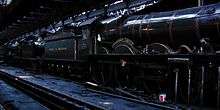 |
Undergoing overhaul | ||||||||||
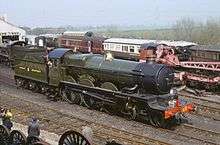 |
Awaiting overhaul. To commence on completion of 60532 Blue Peter. | ||||||||||
 |
(Barbury Castle) |
Undergoing mainline standard overhaul. | |||||||||
(Drysllwyn Castle) |
On static display | ||||||||||
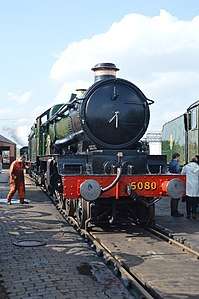 |
(Ogmore Castle) |
Undergoing mainline standard overhaul.[21] | |||||||||
| Undergoing restoration.[22] | |||||||||||
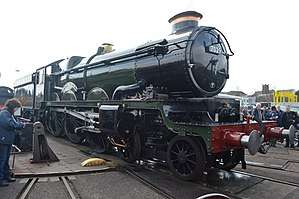 |
Operational, Mainline Certified. |
There is now a Haynes Owner's Workshop Manual available.
Models
Hornby Railways manufacture a model of the 4073 in OO gauge. The Hornby Dublo brand, then owned by Meccano Ltd, also built "Bristol Castle" (released 1957) for their three-rail system and "Cardiff Castle" for the two-rail system two years later; Wrenn continued the Hornby Dublo model when they took over the range. Airfix/GMR (and later Dapol) also produced an OO model; Tri-ang released a TT gauge model; and Graham Farish (later Bachmann) released N gauge models. Many different prototype examples have been depicted by the various manufacturers.
References
- Nock 1980, p. 11
- le Fleming 1953, p. H13
- Nock 1980, p. 92
- le Fleming 1953, p. H17
- le Fleming 1953, p. H17-18
- Nock, O.S. (1969). Kings & Castles of the G.W.R. (2nd ed.). Shepperton: Ian Allan. ISBN 0 7110 0071 9.
- le Fleming 1953, p. H17-19
- Allen, Cecil J (1970). Salute to the Great Western. Shepperton: Ian Allan. ISBN 0 7110 0181 2.
- Kenneth J. Cook (1974). Swindon Steam 1921–1951. Staines, Middlesex: Ian Allan. p. 52.
- Allen, Cecil (1962). Great Western. Ian Allan. p. 64.
- "The most unpronounceable name of any Castle Class Loco !!". Flickr. Retrieved 21 September 2018.
- "Light at the end of the tunnel for Severn 'Prairie'". Steam Railway. Peterborough: Bauer Consumer Media Ltd (455): 40–42. 17 June 2016. ISSN 0143-7232.
- "Four killed and 50 injured in train crash". The Times (51243). London. 1 December 1948. col A-B, p. 4.
- Trevena, Arthur (1980). Trains in Trouble. Vol. 1. Redruth: Atlantic Books. p. 47. ISBN 0-906899-01-X.
- Waters, Laurence (1991). Steam In Action 'Castles'. Shepperton: Ian Allan. ISBN 0 7110 2006 X.
- Riley, R.C. (1966). Great Western Album. Shepperton: Ian Allan. ISBN 0 7110 0073 5.
- "History of 7027 Thornbury Castle". www.thornburycastle7027.co.uk. Thornbury Castle 7027 Society. Retrieved 21 September 2018.
- Realtime Train info 7029's light test runs
- Realtime Train info 7029's loaded test runs
- Holden, Michael (12 December 2019). "Steam locomotive 6023 King Edward II retired from mainline work". RailAdvent. Retrieved 3 July 2020.
- Defiant Club The 5080 Defiant Club
- Steam locomotive 7027 Thornbury Castle set for Great Central Railway restoration
- le Fleming, H.M. (July 1953). White, D.E. (ed.). The Locomotives of the Great Western Railway. Part 8. Modern Passenger Classes (1st ed.). Kenilworth: The Railway Correspondence and Travel Society. ISBN 0-901115-19-3. OCLC 500544523.CS1 maint: ref=harv (link)
- Nock, O. S. (1983). British Locomotives of the 20th Century Vol.1. London: Book Club Associates.CS1 maint: ref=harv (link)
- Nock, O. S. (1980). The GWR Stars, Castles and Kings. London: Book Club Associates.CS1 maint: ref=harv (link)
- Vaughan, Adrian (1989). Obstruction Danger. Wellingborough: Patrick Stephens Limited. ISBN 1-85260-055-1.CS1 maint: ref=harv (link)
- Brian Haresnape (1978). Collett & Hawksworth Locomotives—A Pictorial History. Ian Allan Ltd. ISBN 0-7110-0869-8.
- Whitehurst, Brian (1973). Great Western Engines, Names, Numbers, Types and Classes (1940 to Preservation). Oxford, UK: Oxford Publishing Company. pp. 36–37, 44–46, 64, 103, 143. ISBN 978-0-9028-8821-0. OCLC 815661.
Literature
- Nock, O.S. (1945), "British Locomotive Working in Wartime - The G.W.R. "Castle Class"", The Engineer, 180, in two parts: No.I, 17 Aug., pp.122-125 ; No.II, 24 Aug. 1945., pp.144-146
External links
| Wikimedia Commons has media related to GWR 4073 Class. |
- Daniel, John. "4073 'Castle' class introduction". Great Western steam locomotives.
- 5028 Llantilio Castle Home Page The "life story" of this GWR locomotive.